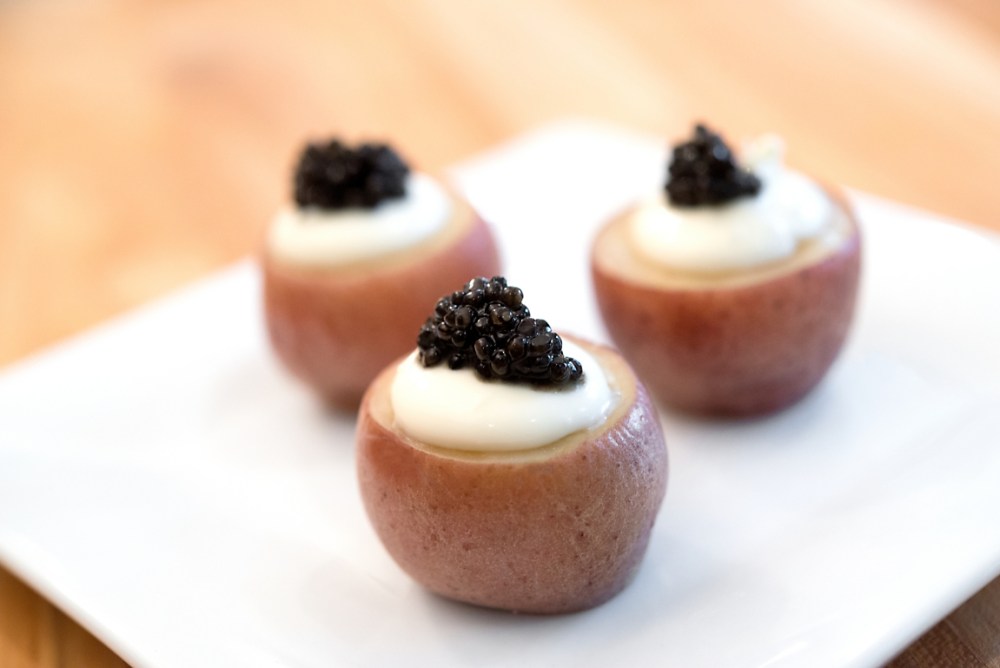What is caviar? Very simply, true caviar is the roe of a sturgeon that has been salted. Prized by cultures going back to Ancient Greece and Rome, and of course, Russia, it still holds allure.
Since today is National Caviar Day, we would like to with you a Happy Caviar Day, and take a closer look at this salty treasure.

One Fish, Two Fish
Caviar isn’t from just any fish, but from the mighty sturgeon. Beluga sturgeon produce the most valuable type of caviar, and take up to 20 years to mature. Today the Beluga sturgeon is critically endangered, so its caviar is no longer imported.
Most caviar now comes from another type of sturgeon. One of the most valued is the Siberian, or Ossetra sturgeon, (Acipenser baerii), which is a freshwater fish native to the Siberian river basins. Although populations in the wild are in decline, the Ossetra sturgeon has adapted well to captive-breeding and farm conditions. Most of the sturgeon caviar on the market today comes from an aqua farm.
Down on the Farm
Our Ossetra Malossol Caviar is raised on an aqua farm, in France, exclusively for D’Artagnan.
At our aqua farm, the wastewater actually runs cleaner than the same water at entry. The sturgeon benefit greatly from the exceptionally pure water, and the humane and pristine conditions in which they are bred and raised.
The roe is removed from the belly of a sturgeon and then sieved delicately by hand; salt is added, and hand-packed into lined caviar tins.

Did You Know?
The term “malossol” is Russian and means “little salt.” Traditionally, before refrigeration, it was difficult to preserve these raw fish eggs and transport them, so plenty of salt was needed. The less salt, the truer the caviar taste; lightly salted caviar was highly prized by the czars and Russian elite.
About Ossetra Caviar
Ossetra caviar ranges in color from warm brown to green-gray in color, to dark blue to jet black or even yellow. It is said to have a distinct flavor, and many caviar gourmands prefer the firm bead, texture, and buttery, rich flavor of Ossetra over all others, even the esteemed Beluga.
Our Ossetra caviar has round, plump grains with a unique, lingering nutty flavor and ultra-silky mouth feel. The color ranges from clear grey to golden chestnut to deep brown.

Serving Caviar
It is recommended that you open the vacuum-sealed tin 15 to 20 minutes before eating; be sure to keep it cold while the caviar is exposed to the air. A bowl of ice chips makes the perfect nest for a tin of these valuable eggs. Scoop the caviar out of the tin carefully, so as not to break the eggs, using a mother of pearl, horn or wooden spoon. Metal spoons should never touch caviar as they can affect the taste.

Caviar is delicious enjoyed simply – atop a round of brioche toast, blini or steamed baby red potato, with or without a dollop of crème fraîche; or in your favorite canapé recipes, like these deviled quail eggs.
Keep it simple, as we have in our caviar recipes, so that the flavor of the caviar gets to shine.

Once opened, it is best to eat caviar quickly, as it does not have a long shelf life. Paired with champagne, sake, vodka or a dry white wine, it’s hard to imagine that there will be any caviar left over.
Eat Your Caviar
Caviar may be delicious, but it also packs plenty of nutritional value. Caviar contains calcium, phosphorus, selenium, iron, magnesium, and Vitamins B12, B6, B2, B44, C, A, and D. It’s got amino acids and omega-3 fatty acids to recommend it as well. So eat your caviar!
